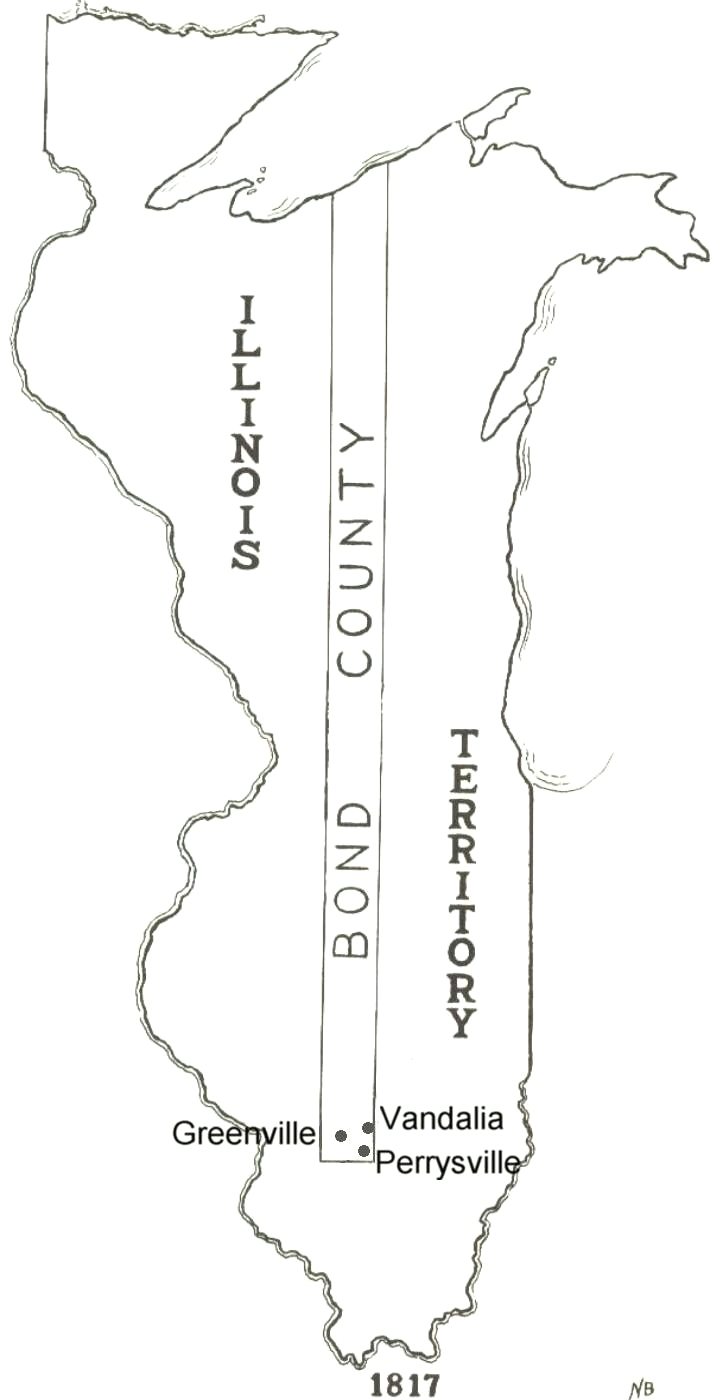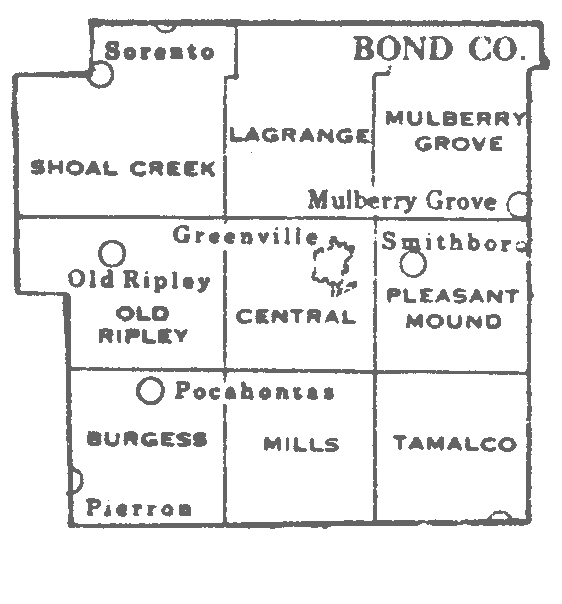Bond County Bicentennial
1817 - 2017
Our Story
A 200 Year Journey
Early Bond County History
Bond County is today one of Illinois’ smallest counties, both in size and population. In 2013 the U.S. Census Bureau reported the population was 17,460. However, it has a rich and important history that pre-dates statehood.
The first permanent settlers in what is now Bond County are believed to have arrived in 1806. The Reavis and Greene families, and a Mr. Jones are the first known settlers.
Isaac Hill was an early settler, surveyor, and map maker. By 1908 he had founded a fort site located near Shoal Creek, about 6 miles southwest of present day Greenville. Jones’ Fort and Lindley Fort were also located in the region. These early forts housed frontier Rangers and protected settlers from Indian attacks.
Hill’s Fort was involved in a battle that is considered part of the War of 1812. On September 9, 1814, a group of Indians ambushed rangers and settlers just outside the fort. Four rangers were killed protecting the fort: William Grotts, John Journey, William Pruitt, and Robert Lynn.
The first town founded in what is now Bond County was Ripley, along the banks of Shoal Creek near present day Old Ripley. It was founded in 1814 by the Wheelock brothers and had a mill and store.
Greenville was founded by George Davidson in 1815. Davidson built a home and tavern on a bluff overlooking Little Shoal Creek.
Bond County was formed on January 4, 1817 by an act of the Illinois Territorial Legislature. It was taken entirely from Madison County. Bond County was initially 24 miles wide east to west, and over 600 miles long north to south.
Bond County’s original western border is predominately its current one. Its original eastern border was six miles east of its current one, and included parts of what is now Vandalia. Its southern border was six miles south of its current border. Its northern border was the shoreline of Lake Superior. What was once Bond County, is now part of the states of Illinois, Wisconsin, and Michigan.
Bond County was named for Shadrach Bond, who had been a farmer, a politician, an army colonel during the War of 1812, and at the time was Receiver of Public Money. Bond lived near Kaskaskia and had served as the Representative for the Illinois Territory to the US Congress from 1812 to 1814. Bond would later be elected the first Governor of the State of Illinois in 1818.
Hill’s Fort was named as the first seat of Bond County. The first court session was held there on May 30, 1817.
According to tax rolls from 1817, there were seven slaves in Bond County brought in from other states by four different owners. Slavery of all kinds was formally abolished in Illinois in 1824.
In 1817 the location for a new county seat was chosen by commissioners at Hill’s Fort. They selected a site on the west bank of Hurricane Creek, about four miles southeast of the current town of Mulberry Grove. The town of Perrysville (later Perryville, and now long an historic memory) was platted and recorded on May 17, 1818. A jail and courthouse were later built there.
A town named Independence was also platted in 1818. It was about two miles south of Perrysville, near the Kaskaskia River.
The first election in Bond County was held at Perrysville on July 6, 1818. The election was to choose the delegates to represent Bond County at the Constitutional Convention for Illinois Statehood in Kaskaskia. Only 91 men voted in that first election, and Samuel Morse and Thomas Kirkpatrick were chosen.
Bond County was one of 15 counties in the Illinois Territory represented at the first State Constitutional Convention. Its delegates helped shape state government and establish its laws. At the convention, the Wheelock Brothers offered free land to make Ripley the state capital. The offer was not accepted.
Illinois was made a state on December 3, 1818. Bond County’s new northern border became the state border.
Vandalia was chosen as the new state capital in 1821. That year the counties of Fayette and Montgomery were created and they each took part of Bond County. As a result, Perrysville was in Fayette County, and Bond County would have to establish a new county seat.
A commission was formed to select a new Bond County Seat. Greenville was chosen as it was nearly in the center of the county. George Davidson, founder of Greenville, offered the county one block of land between Second and Third Streets, and all the lots on each side facing that block. The extra lots could be sold to raise money for the construction of a courthouse. The county accepted his offer and Greenville, one of Illinois’ oldest towns having been founded in 1815, has been the county seat since.
The first court was held in Greenville on June 4, 1821. The first lots facing the courthouse square were sold in July of that year. By 1822 a new courthouse was constructed on the same site as the current courthouse.
In 1824 Clinton County was formed partially out of Bond County. The county’s southern border was set to its current location.
In 1843 the Illinois Legislature took a small section of land from Madison County and made it part of Bond County to compensate for its previous reductions. Inclusion of that notch in the northwest corner was the last change to the boundaries of Bond County and established its current size and shape.
In 1883 a fire destroyed the Bond County Courthouse in Greenville. In 1884 construction of a new courthouse began and was completed in 1885. That building still stands and is still the current Bond County Courthouse.
In 1889 Bond County adopted its current nine township governments. They are: Shoal Creek, La Grange, Mulberry Grove, Pleasant Mound, Central, Old Ripley, Burgess, Mills, and Tamalco.
In the end it is more than simply this rich political and geographical history that gives Bond County, Illinois its greatness. It is the way of life of its citizens: its tradespeople, laborers, agricultural workers, professionals, miners, homemakers, teachers, soldiers, clergy, volunteers, and public servants. It is the way friends, co-workers, family, and neighbors support each other and pull together. It is these people - each of their integral parts in a storied community, both traditional and progressive, 200 years in the making - that we celebrate on the occasion of our Bicentennial.
Find a great deal more information about Bond County’s people and places in the publications written by our own authors and historians.
Our Communities
Ayers - Beaver Creek - Donnellson - Dudleyville - Durley - Elm Point - Greenville - Hamburg - Hookdale - Keyesport - Millersburg - Mulberry Grove - Newport - Old Ripley - Panama - Pierron - Pocahontas - Reno - Smithboro - Sorento - Stubblefield - Tamalco - Wisetown - Woburn.
Our Authors and Historians
The following volumes and collections are a selected reading list. A few (marked with asterisk *) are available for purchase at area retailers such as Pocahontas Mercantile, Third Street Market, CVS Drug Store - Greenville, or Bond County Historical Society’s Bond County Museum gift shop. Many are now out-of-print but can be read at Bond County Genealogical Society’s Research Library (in the lower level of Greenville Public Library). Some can be found, digitally archived at Internet Archive.
- Bond County Illinois History (includes Family Profiles) i.e. the “Red Book” by BCHS, (1979)
- Bond County, Illinois, Records and Traditions (4 volumes) by John H. Nowlan
- Historical Stories: About Greenville and Bond County, Illinois by Allan H. Keith, (2002) [Read Online]
- Images of America: Greenville and Bond County by Kevin John Kaegy and BCHS, (2003)*
- Hundreds of Greenville Photographs by Dr Daniel Junod - facebook.com/DrDanielJunod/
- History of Bond and Montgomery Counties, Illinois (includes Family Profiles) by William Henry Perrin, (1882) [Read Online]
- Portrait and Biographical Record of Montgomery and Bond counties, Illinois by Chapman Publishing Company, (1892) [Read Online]
- Historical Souvenir of Greenville, Illinois by Will C. Carson, (1905) - Bicentennial Reprint with Annotated Photograph Index, (2015)* [Read Online]
- Tales, Trails & Breadcrumbs, 1838-1938, One Hundred Years, Bond County, Illinois by Eleanor Wilson, (2003)* [Read Online]
- This is Fred Baumberger with the Farm Report from WGEL: a compilation of farm reports from 1997-2010 by Fred Baumberger, (2011)
- Mulberry Grove, Illinois, Community Sesquicentennial, 1834-1984 (includes Family Profiles) by Mulberry Grove Lions Club
- Smithboro, 80 years and more by Elva C. Elam
- Pocahontas, Illinois, Sesquicentennial, 1835-1985 (includes Family Profiles)
- The Story of Early Pocahontas & Sugg Cemetery by BCGS by Gerald Jenner, (1988) [Read Online]
- My Favorite Country Corner : History of Pleasant Mound area by Harold Leidner, (1994)
- Pleasant Mound, Fairview : Glimpses & Memories of a Little Farm Town that Flourished by Janice E. Baldwin and friends; foreword by Kevin Kaegy; editors Jeanette Dothager and Kayla Hays, (2012)*
- Many Journeys : a History of the People Buried in Maxey, Seagraves, Hall’s Grove, and Gurham Cemeteries, Bond County, Illinois by Harold Leidner, (1991)
- History of Shoal Creek and Ripson Bridge (Vol I and Vol III available) by Lillian Dauderman [Read Online]
- The Story of Old Mt. Nebo and the Families Buried There by Gerald Jenner, (1990) [Read Online]
- Mt. Gilead Cumberland Presbyterian Church & Cemetery History, 1819-1993 by Gerald Jenner [ Read Online]
- Sorento, a History of the Town and its People, 1820-1984 by Sorento Homecoming Assoc. [Read Online]
- Sorento Centennial, 1882-1982 [Read Online]
- Ta’s True Tales (more Sorento stories) by Lillian Enloe Dauderman [Read Online]
- Panama, an Illinois Coal Mining Town, 1905-1927 (in three volumes) by Dale & Geraldine Eccles [Read Online]
- Village of Panama, 100 Years In The Making, by John Hancock [Read Online]
- Donnellson Illinois Centennial, 1897-1997; incorporated 1897; One Hundred Years Remembered
- Brief history of Woburn, Illinois, and Woburn School, Dist. 20, Bond Co. by Glen Diamond, (1991)
- Old Ripley, Illinois, est. 1906 by Gladys Schmollinger & Tara Godier
- The Tales of Hill’s Fort : and other Bond County Stories During the War of 1812 by William Wilson and Kevin Kaegy, (2003)*
- Hill’s Fort, the Tales Continue : along with Other Bond County Stories by William Wilson & Kevin Kaegy, (2010)*

